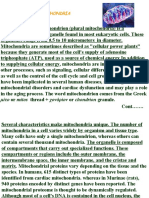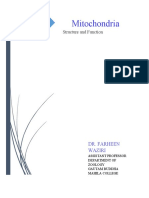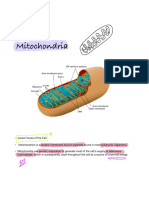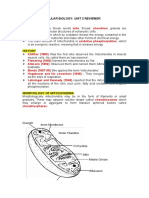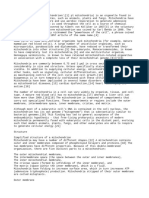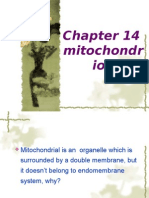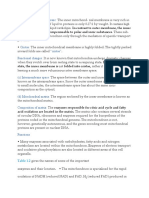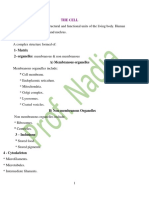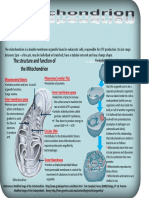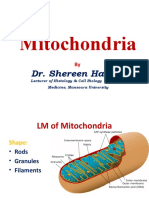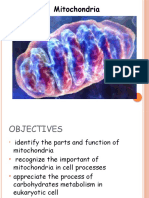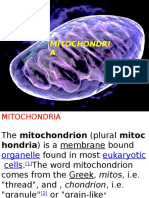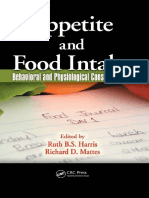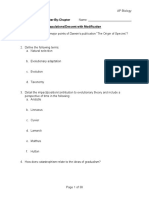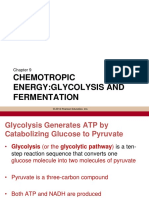Mitochondrial Structure and function
Mitochondria are large enough to be seen in the light microscope. Mitochondria can appear
as individual bean- shaped organelles, ranging from 1 to 4µm in length. At the other end of
the spectrum, mitochondria can appear as a highly branched, interconnected tubular
network. These organelles are known for their role in generating the ATP that is used most
of the cells energy requiring activities. Mitochondria also play a vital role in the uptake and
release of calcium ions. Mitochondria ( along with ER) play an important role in regulating
the calcium concentration of the cytosol.
Mitochondrial membrane:
Mitochondria contains two membranes: the outer mitochondrial membrane and the inner
mitochondrial membrane. The outer mitochondrial membrane completely closes the
mitochondria, serving as its outer boundary. The inner mitochondrial membrane is
subdivided into two that have different protein residents and carry out distinct functions.
One of these domains called , called the inner boundary membrane, inside the outer
mitochondrial membrane, forming a double membrane outer envelope. The inner
boundary membrane rich in proteins responsible for the import of mitochondrial proteins.
The other domain of the inner mitochondrial membrane is present within the interior of
the organelle as a series of invaginated membranous sheete, called cristae.
The cristae contain a large amount of membrane surface, for aerobic respiration and ATP
formation. The inner boundary membrane and internal cristal membranes are joined to one
another by narrow tubular connections or cristeae junctions.
The membranes of the mitochondrion divide the organelle into two aqueous
compartments, one with in the interior of the mitochondrion, called the matrix,and
second between the outer and inner membrane, called the intermembrane space.The
matrix has a gel like consistency to the presence of high concentration of water soluble
� proteins. The proteins of the intermembrane space are known for their role in initiating
cell suicide.
The outer and inner membrane s have very different properties. The outer membrane is
composed of 50percent lipid and a mixture of enzymes and the inner membrane contains
100 different polypeptides and very high protein /lipid ratio( more than 3:1 ,which is one
protein molecule for every 15 phospholipids).
The outer mitochondrial membrane is homologous to an outer membrane present as part
of the cell wall of certain bacterial cells. The outer mitochondrial membrane and outer
bacterial membrane both contain porins. When the porin channels are wide open , the
outer membrane is permeable to molecules such as ATP, NAD, and coenzyme A, which
have key roles to play in energy metabolism within in the mitochondrion. In contrast , the
inner mitochondrial membrane is highly impermeable, all molecules and ions require
special membrane transporters to gain entrance to the matrix.
Structure
�Mitochondrion ultrastructure :A mitochondrion has a double membrane; the inner one
contains its chemiosmotic apparatus and has deep grooves which increase its surface area.
While commonly depicted as an "orange sausage with a blob inside of it" (like it is here),
mitochondria can take many shapes and their intermembrane space is quite thin.
Composition of Mitochondria:
A mitochondrion contains outer and inner membranes composed of phospholipid bilayers and
proteins. The two membranes have different properties. Because of this double-membraned
organization, there are five distinct parts to a mitochondrion. They are:
1. the outer mitochondrial membrane,
2. the intermembrane space (the space between the outer and inner membranes),
3. the inner mitochondrial membrane,
4. the cristae space (formed by infoldings of the inner membrane), and
5. the matrix (space within the inner membrane).
Mitochondria stripped of their outer membrane are called mitoplasts.
Outer membrane:
The outer mitochondrial membrane, which encloses the entire organelle, is 60 to 75
angstroms (Å) thick. It has a protein-to-phospholipid ratio similar to that of the cell
membrane (about 1:1 by weight). It contains large numbers of integral membrane proteins
called porins. A major trafficking protein is the pore-forming voltage-dependent anion
channel (VDAC). The VDAC is the primary transporter of nucleotides, ions and metabolites
between the cytosol and the intermembrane space.
The outer membrane also contains enzymes involved in such diverse activities as the
elongation of fatty acids, oxidation of epinephrine, and the degradation of tryptophan. These
enzymes include monoamine oxidase, rotenone-insensitive NADH-cytochrome c-reductase,
kynurenine hydroxylase and fatty acid Co-A ligase. Disruption of the outer membrane
permits proteins in the intermembrane space to leak into the cytosol, leading to certain cell
death.[52] The mitochondrial outer membrane can associate with the endoplasmic reticulum
(ER) membrane, in a structure called MAM (mitochondria-associated ER-membrane). This is
important in the ER-mitochondria calcium signaling and is involved in the transfer of lipids
between the ER and mitochondria.[53] Outside the outer membrane there are small (diameter:
60Å) particles named sub-units of Parson. Intermembrane space:
The mitochondrial intermembrane space is the space between the outer membrane and the
inner membrane. It is also known as perimitochondrial space. Because the outer membrane is
freely permeable to small molecules, the concentrations of small molecules, such as ions and
sugars, in the intermembrane space is the same as in the cytosol.[17] However, large proteins
must have a specific signaling sequence to be transported across the outer membrane, so the
protein composition of this space is different from the protein composition of the cytosol.
One protein that is localized to the intermembrane space in this way is cytochrome c.[52]
Inner membrane:
�Inner mitochondrial membrane:
The inner mitochondrial membrane contains proteins with three types of functions:
1. Those that perform the electron transport chain redox reactions
2. ATP synthase, which generates ATP in the matrix
3. Specific transport proteins that regulate metabolite passage into and out of the
mitochondrial matrix
It contains more than 151 different polypeptides, and has a very high protein-to-phospholipid
ratio (more than 3:1 by weight, which is about 1 protein for 15 phospholipids). The inner
membrane is home to around 1/5 of the total protein in a mitochondrion.[54] Additionally, the
inner membrane is rich in an unusual phospholipid, cardiolipin. usually characteristic of
mitochondrial and bacterial plasma membranes. Cardiolipin contains four fatty acids rather
than two, and may help to make the inner membrane impermeable. Unlike the outer
membrane, the inner membrane does not contain porins, and is highly impermeable to all
molecules. Almost all ions and molecules require special membrane transporters to enter or
exit the matrix. In addition, there is a membrane potential across the inner membrane, formed
by the action of the enzymes of the electron transport chain.
Cristae:
The inner mitochondrial membrane is compartmentalized into numerous cristae, which
expand the surface area of the inner mitochondrial membrane, enhancing its ability to
produce ATP. These folds are studded with small round bodies known as F1 particles or
oxysomes. These are not simple random folds but rather invaginations of the inner
membrane, which can affect overall chemiosmotic function.[58]
Matrix:
Mitochondrial matrix:
The matrix is the space enclosed by the inner membrane. It contains about 2/3 of the total
proteins in a mitochondrion. The matrix is important in the production of ATP with the aid of
the ATP synthase contained in the inner membrane. The matrix contains a highly
concentrated mixture of hundreds of enzymes, special mitochondrial ribosomes, tRNA, and
several copies of the mitochondrial DNA genome. Of the enzymes, the major functions
include oxidation of pyruvate and fatty acids, and the citric acid cycle. The DNA molecules
are packaged into nucleoids by proteins, one of which is TFAM.
Mitochondria have their own genetic material, and the machinery to manufacture their own
RNAs and proteins .
Marker enzymes:
Marker enzymes are enzymes, which are not ubiquitous but a specific type of organelle, a
subcomponent, or a cell. For example, succinate dehydrogenase is a marker enzyme for
mitochondrion . marker enzymes are not to be found just anywhere else, their detection can indicate
the presence of the source whereas their absence that means the lack of that source. Marker enzymes
are one of the cell biomarker used to characterize the cell type. They are also used in isolation of
�target cellular component.
�Semiautonomous nature of mitochondria:
II. The Endosymbiotic Theory ... first postulated by Lynn Margulis
in the 1967.
The endosymbiotic hypothesis for the origin of mitochondria (and chloroplasts) suggests that
mitochondria are descended from specialized bacteria (probably purple nonsulfur bacteria) that
somehow survived endocytosis by another species of prokaryote or some other cell type, and
became incorporated into the cytoplasm.
[Endo = "within"]
[Endocytosis = (cyto = cell) a process of 'cell eating' - cells are engulfed, but then
usually digested as food....]
[Endosymbiosis = cells are engulfed, but not digested...cells live together is a
mutually benefitting relationship, or symbiosis]
�Her hypothesis originally proposed that:
mitochondria are the result of endocytosis of aerobic bacteria
chloroplasts are the result of endocytosis of photosynthetic bacteria
in both cases by large anaerobic bacteria able to exist in an aerobic
environment.
this arrangement became a mutually beneficial relationship for both cells
(symbiotic).
Margulis' original hypothesis proposed that aerobic bacteria (that require
oxygen) were ingested by anaerobic bacteria (poisoned by oxygen), and may
each have had a survival advantage as long as they continued their partnership.
Each would have performed mutually benefiting functions from their symbiotic
relationship. The aerobic bacteria would have handled the toxic oxygen for the
anaerobic bacteria, and the anaerobic bacteria would ingested food and
protected the aerobic "symbiote"..
The result = a cell with a double-membrane bound organelle. The inner lipid
bilayer would have been the bacterial cell's plasma membrane, and the ouler lipid
bilayer came from the cell that engulfed it.
[mitochondria are the result of endocytosis of aerobic bacteria
chloroplasts are the result of endocytosis of photosynthetic bacteria
in both cases by large anaerobic bacteria who would not otherwise be able
to exist in an aerobic environment.
this arrangement became a mutually beneficial relationship for both cells
(symbiotic).



